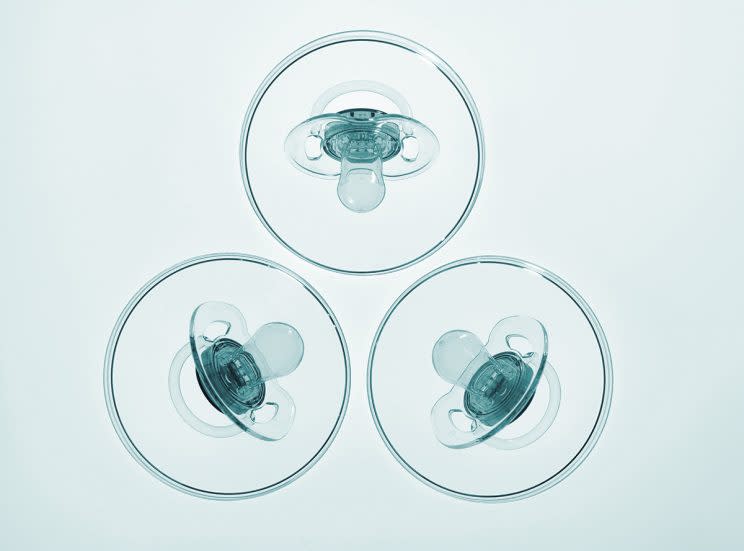Scientists Increase a Woman’s Egg Supply During IVF With This Cool Technique

When couples are struggling to conceive, they often turn to in vitro fertilization. But while the procedure has helped many couples go on to have healthy pregnancies, egg supply is always a concern — especially with older women.
Now new research may have found the answer. Scientists from the Oregon Health and Science University in Portland have discovered a technique that uses an egg’s genetic leftover to double the number of eggs that are collected in IVF.
The method is slightly more complicated than the traditional egg harvesting that currently is a step in IVF, as it requires another person to donate healthy eggs. However, the embryos that result would be related to the mother. (The results of the study are published in the journal Cell Stem Cell.)
In IVF, a woman takes a round of hormones that stimulates more eggs to mature and be released than normal. Then a doctor removes the eggs and pairs them with sperm from the woman’s partner (or a donor) to create embryos. The embryos that are deemed the healthiest are then implanted in the woman’s uterus, resulting in a pregnancy.
According to New Scientist, women can produce up to 15 eggs using this method, but the number can be much lower if a woman is older or has a low egg reserve. As a result, women may have to go through more rounds of IVF, which is costly. (According to IHR.com, a directory of infertility IVF clinics, the average cost of IVF is $12,000 to $15,000, and insurance companies often don’t cover it.)
For the latest research, Shoukhrat Mitalipov, PhD, director of the Oregon Health and Science University’s Center for Embryonic Cell and Gene Therapy, and his team took eggs from 11 volunteers via the usual IVF method. When egg cells are formed, they create smaller cells — known as polar bodies — which eventually degrade. However, these polar bodies contain the same DNA as a normal, developing egg.
Researchers harvested the eggs at the same time as the first polar bodies were forming, and, instead of getting rid of the polar bodies, they placed them next to an egg donated from another woman that had its nucleus (which contains DNA) removed. The donor eggs ended up incorporating the polar bodies, forming a new cell nucleus that replaced the old.
As a result, the women had a set of her own eggs, which were harvested the traditional way, as well as new eggs that contained her DNA in the cell’s nucleus. (The new eggs did carry a small amount of donor DNA in the cell’s mitochondria, however.)
Researchers then fertilized the eggs with sperm and many — but not all — of the new eggs looked normal, under genetic testing.
Mitalipov tells Yahoo Beauty that his team based their work on early mouse studies done in 1997. Since scientists weren’t able to find the same success with other species, “we were surprised to find out that human polar bodies support formation of viable eggs and, later, normal embryos,” he says.
Mitalipov says there are potential concerns, including the fact that the child conceived with this technique will have most of its genes from its mother but some DNA from an egg donor. “Another concern is that some eggs generated with this technique may carry chromosomal abnormalities,” he says.
But Jane Frederick, MD, a board-certified reproductive endocrinologist at HRC Fertility, tells Yahoo Beauty that it’s “far too early” to know if this will have an impact on IVF and fertility for women. “There are many factors to consider, and like all procedures and processes in IVF, it will take great research and experimentation to prove that this will actually be proven as successful form of treatment,” she says.
Edward Marut, MD, of Fertility Centers of Illinois, tells Yahoo Beauty that the idea is “interesting” but points out that if the eggs are genetically abnormal to begin with, a patient may wind up with a larger harvest of abnormal eggs. “There is no guarantee a larger harvest of eggs will result in a higher amount of healthy eggs for IVF,” he says. “Without long-term research, we also do not know if the chromosomal makeup of the hybrid egg maintains its genetic normalcy.”
Also, Tina Koopersmith, MD, founder of West Coast Women’s Reproductive Center, tells Yahoo Beauty that the donor egg element is a concern. “Donor eggs are still required, so unless there is a bank with ample donor eggs lying around, this may still be a costly endeavor involving three individuals,” she says.
However, Mitalipov is hopeful that his technique will help future IVF patients conceive. “Our goal is to further test and perfect the technique so eventually it can be safely used in IVF to increase pregnancy rates for patients,” he says.
Let’s keep in touch! Follow Yahoo Beauty on Facebook, Twitter, Instagram, and Pinterest.
